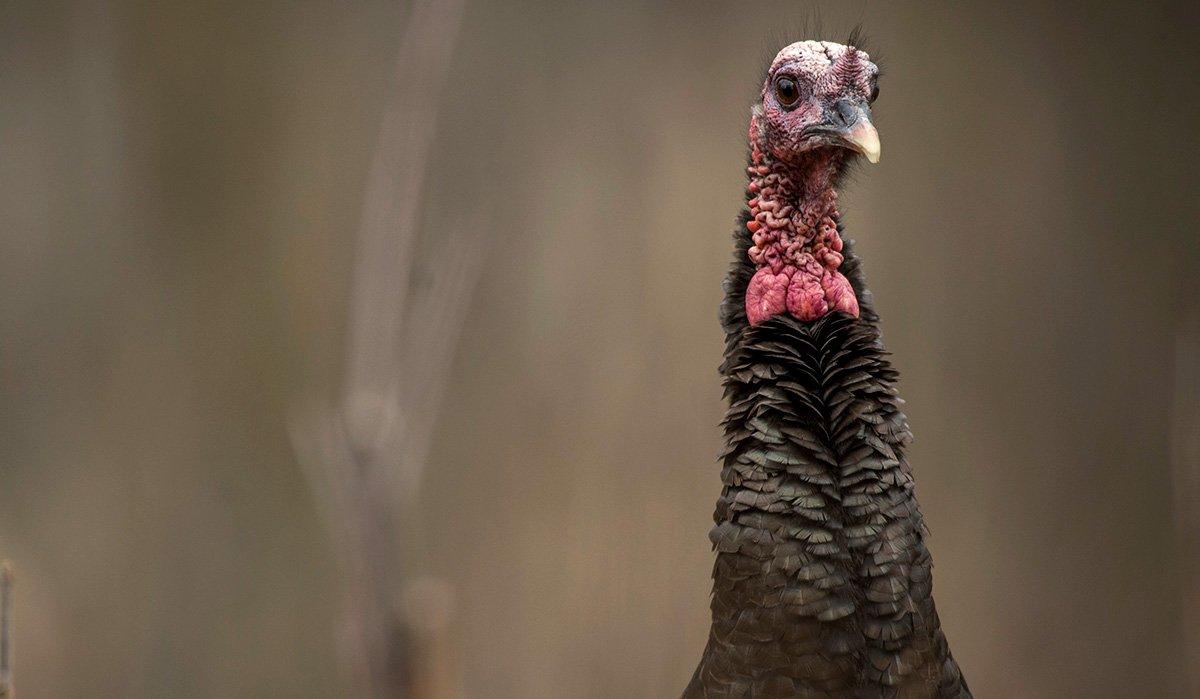Call right, sit tight, and put an autumn longbeard in your game vest
We had scattered the gobbler gang with dogs trained to the task. It was a group of red-headed birds, coal-black with swinging beards sailing off in five different directions. They'd make us pay that sunny but bitter cold, early November day. Yep, we'd have to put in our time.
After nearly two hours of butt shifting and gobbler yelping and shaking off the chills, we were treated to the vision of two toms suddenly appearing like in-range hallucinations right there at the break site where we'd set up. My buddy killed one without ceremony and returned to camp — his Snoopy dance came later — as the other bird sprang straight up and banked down the ridge, gone, for now.
Well, whaddya want to do? asked my other bud, likely chilled to the core as much as me. Let's sit some more, I said, teeth chattering a little. I was hoping you'd say that, he said, smiling back. And so we did. Two more body-chilling hours ticked by before the turkey that had banked down the hill after the shot started yelping back at my friend's calling. At that, another bird up the hill — silent for the past four full turns of the clock — chimed in. I spun around to face its direction.
Not long after, the gobbler appeared, stalking down the hill like Count Dracula, its head flushing red, white, and blue with regrouping anticipation. As it minced steps into view, I watched, waited, picked my moment, and killed it. I felt a lot warmer after that: calling right, post-scatter; sitting tight, with dedicated patience. It's really pretty simple. But fall gobblers still win most of the time.
Scatter Shot
Scattering fall turkeys is a proven tactic. Some do it by touching off a shotgun volley in a safe direction — above a ridgetop running or hillside flock if you can — close enough to the flock to get them running and flying off in different directions.
Turkey dogs do it even better, barking on the break, and the flock's alarm putting, wing-flushing visuals, and the sound of snapping branches also keys you in to the scatter site. You'll set up there for the call-back session.
Yes, there are doubters. It seems counterproductive to the uninitiated, but separated birds want to get back together. And yes, it sometimes takes longer for older gobblers to do it. You just have to put in your time to make it work.
An hour or two's sit, staying hidden and calling at your setup, isn't unusual. Or longer. It's true, maybe those gobblers will finally get together the next morning. But autumn male turkeys will also regroup fairly soon. The key is to know when you've gotten a good break on birds. And then put in your time, the same way you might on a treestand for a big buck. Pay the price.
Wait It Out
If you've flushed longbeards and feel it's a good break (flocked turkeys scattered in all directions), you should essentially camp out as they say. There is a reason they ran together in the first place. They'll want to regroup. Maybe it'll happen within the hour, or several hours. Maybe you'll have to wait until just before fly-up time.
Was your scatter good? If they still haven't returned to the flush site, get back there the next morning if you can. This time things might just happen faster.
If the original flush was competent, but not the best, it might be a matter of reflushing gobblers on foot or with a canine if you can (as of this writing, 29 states permit turkey dogging in the fall). Or simply move on to hunt fresh turkeys.
Call as They Do
A mature fall gobbler is the epitome of a paranoid survivalist. You've got to adjust your calling tactics to pull one into range.
Gobbler yelps are deeper and have a slower cadence than the higher-pitched hen yelps we use in the spring. Often three deeper, slower yelps will get the interest of a super jake (a 1 1/2-year-old male turkey) or a mature gobbler. Gobbler calls, used sparingly, can draw responses from adult toms, super jakes, and young male turkeys. If you've broken the flock on foot, or with a dog where legal, listen as the gobblers regroup. Often, they'll gobble when looking for other turkeys.
As fall longbeards go, you're never more on turkey time — meaning they set the pace of the game, and not you. Be patient. Enjoy it all, even the waiting part. Scattered right, they will likely want to get back together. Just be there when they do.
[How to Find (and Bust) Fall Turkeys]








